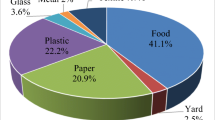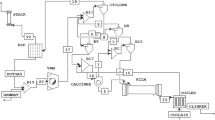Abstract
The current practice of monitoring air emission from an incineration plant is through a hardware system known as Continuous Emission Monitoring Systems (CEMSs). Considering that CEMS suffers from high installation and maintenance cost, thus, the present work focuses on a modelling technique through an Adaptive Neuro-Fuzzy Inference System (ANFIS) to develop a predictive model of carbon monoxide (CO) emission utilizing actual data taken from a clinical waste incineration plant having capacity to process 250 kg waste/h. An hourly averaged of 1000 data points consisted of nine input–output data pairs was utilized to develop a Sugeno-type fuzzy structure by applying subtractive clustering method. As the data were divided into three sets, i.e. 70% for training, 15% for checking and the rest for testing, the values of the coefficient of determination (R 2), root-mean-square error (RMSE), mean bias error (MBE) and accuracy (Ac) were calculated for each set to demonstrate its applicability and validity, emphasizing on the testing set since unseen data were exposed to the model. Result showed that ANFIS was able to learn from these data and excellently predicted the CO emission with R 2, RMSE, MBE and Ac of 0.98, 4.45, 0.66 ppm and 87.98% in the testing set, respectively.











Similar content being viewed by others
References
Ambali AR, Bakar AN, Merican FM (2013) Environmental policy in malaysia: biomedical waste, strategies and issues. J Adm Sci 10:1–17
Baharun S, Adnan R, Mohamad I et al (2005) Variables affecting the combustion efficiency of a clinical waste incineration process. J Teknol 42:11–24
Blenkharn JI (2005) Safe disposal and effective destruction of clinical wastes. J Hosp Infect 60:295–297. doi:10.1016/j.jhin.2005.01.029
Baines G (1999) Neural networks for boiler emission prediction. In: Proceedings of 16th IEEE instrumentation and measurement technology conference (Cat. No. 99CH36309), pp 435–439
Pathmanathan E, Ibrahim R, Asirvadam VS (2012) Development of CO2 emission model of an acid gas incinerator using Nelder-Mead least squares support vector regression. Trans Inst Meas Control. doi:10.1177/0142331211425404
Azid IA, Yusoff A, Seetharamu K, Ahmad A (2003) Application of back propagation neural network in predicting palm oil mill emission. ASEAN J Sci Technol Dev 20:71–86
Zheng LZL, Yu SYS, Yu MYM (2008) Monitoring NOx emissions from coal fired boilers using generalized regression neural network. 2nd IEEE international conference of bioinformatics and biomedical engineering, pp 1916–1919. doi:10.1109/ICBBE.2008.808
Mussatti DC, Groeber M, Maloney D (2000) Section 2 Chapter 4 generic equipment and devices. Env Prot Agency 4-1-4–40
Sadeghian AR, Lavers JD (1999) Nonlinear black-box modeling of electric arc furnace: an application of fuzzy logic systems. In: Fuzzy systems conference proceedings, IEEE international, August 22–25, 1999, Seoul, Korea
Navghare S, Bodhe G, Shruti (2011) Design of adaptive pH controller using ANFIS. Int J Comput Appl 33:41–48
Ahmad AL, Azid IA, Yusof AR, Seetharamu KN (2004) Emission control in palm oil mills using artificial neural network and genetic algorithm. Comput Chem Eng 28:2709–2715. doi:10.1016/j.compchemeng.2004.07.034
Aziz IA (2004) Sensitivity analysys via artificial neural network of biomass boiler emission. J Mek 18:66–77
Fuad M, Hussain M (2013) Machine learning based modeling for solid oxide fuel cells power performance prediction. In: Proceedings of 6th international conference on process system engineering (PSE ASIA), pp 19–24
Khoshnevisan B, Rafiee S, Omid M, Mousazadeh H (2014) Development of an intelligent system based on ANFIS for predicting wheat grain yield on the basis of energy inputs. Inf Process Agric 1:14–22. doi:10.1016/j.inpa.2014.04.001
Das MK, Kishor N (2009) Adaptive fuzzy model identification to predict the heat transfer coefficient in pool boiling of distilled water. Expert Syst Appl 36:1142–1154. doi:10.1016/j.eswa.2007.10.044
Saiful Idzwan B, Phing CC, Kiong TS (2014) Prediction of Nox using support vector machine for gas turbine emission at Putrajaya power station. J Adv Sci Eng Res 4:37–46
Mahmoudzadeh S, Othman Z, Yazdani AM, Bakar AA (2013) Carbon monoxide prediction using artificial neural network and imperialist competitive algorithm. Aust J Basic Appl Sci 7:735–744
Hosoz M, Ertunc HM, Karabektas M, Ergen G (2013) ANFIS modelling of the performance and emissions of a diesel engine using diesel fuel and biodiesel blends. Appl Therm Eng 60:24–32. doi:10.1016/j.applthermaleng.2013.06.040
Pathmanathan E, Ibrahim R (2010) Development and implementation of fuzzy logic controller for flow control application. Intell Adv Syst (ICIAS). doi:10.1109/ICIAS.2010.5716249
Rezaeianzadeh M, Tabari H, Arabi Yazdi A et al (2013) Flood flow forecasting using ANN, ANFIS and regression models. Neural Comput Appl 25:25–37. doi:10.1007/s00521-013-1443-6
Fernandez De Canete J, Garcia-Cerezo A, Garcia-Moral I I et al (2013) Object-oriented approach applied to ANFIS modeling and control of a distillation column. Expert Syst Appl 40:5648–5660. doi:10.1016/j.eswa.2013.04.012
Khoshnevisan B, Iqbal J, Omid M et al (2014) A comparative study between artificial neural networks and adaptive neuro-fuzzy inference systems for modeling energy consumption in greenhouse tomato production—a case study in Isfahan Province. JAST 16:1–14
Metin Ertunc H, Hosoz M (2008) Comparative analysis of an evaporative condenser using artificial neural network and adaptive neuro-fuzzy inference system. Int J Refrig 31:1426–1436. doi:10.1016/j.ijrefrig.2008.03.007
Jang J-SR (1993) ANFIS: adaptive-network-based fuzzy inference systems. IEEE Trans Syst Man Cybern 23:665–685. doi:10.1109/21.256541
Takagi T, Sugeno M (1985) Fuzzy identification of systems and its applications to modelling and control. IEEE Trans Syst Man Cybernatics SMC-15:116–132
Grigorie TL, Botez RM (2009) Adaptive neuro-fuzzy inference system-based controllers for smart material actuator modelling. Proc Inst Mech Eng Part G J Aerosp Eng 223:655–668. doi:10.1243/09544100JAERO522
Shahbazian M, Jazayerirad H, Ebnali M (2014) ANFIS based identification and control of distillation process. J Autom Control 2:49–56. doi:10.12691/automation-2-2-3
Marija S, Ivan M, Zivan Z (2013) An ANFIS—based air quality model for prediction of SO2 concentration in urban area. Serbian J Manag 8:25–38. doi:10.5937/sjm8-3295
Jang J (1996) Input selection for ANFIS learning. Proc IEEE 5th Int Fuzzy Syst. doi:10.1109/FUZZY.1996.552396
The Mathworks Incorporation (2016) MathWorks: subclust. In: MathWorks Doc. https://www.mathworks.com/help/fuzzy/subclust.html. Accessed 10 Oct 2016
Al Shamisi MH, Assi AH, Hejase HA (2011) Using MATLAB to develop artificial neural network models for predicting global solar radiation in Al Ain City–UAE. In: Assi AH (ed) Comput Inf Sci Eng Educ Res using MATLAB. InTech, pp 219–238
Moghaddamnia A, Ghafari Gousheh M, Piri J et al (2009) Evaporation estimation using artificial neural networks and adaptive neuro-fuzzy inference system techniques. Adv Water Resour 32:88–97. doi:10.1016/j.advwatres.2008.10.005
Castellanos F, James N (2009) Average hourly wind speed forecasting with ANFIS. In: 11th American conference on wind engineering. San Juan, Puerto Rico
Gopalakrishnan K, Mudgal A, Hallmark S (2011) Neuro-fuzzy approach to predictive modeling of emissions from biodiesel powered transit buses. Transport 26:344–352. doi:10.3846/16484142.2011.634080
USEPA (2002) Part 60-Standards of performance for new stationary sources. Title 40 Appendix B. Code of Federal Regulations. United State
Acknowledgements
The authors expressed their appreciation to the Malaysia Japan International Institute of Technology, University Technology Malaysia (MJIIT UTM) for the financial support to the first author.
Author information
Authors and Affiliations
Corresponding author
Ethics declarations
Conflict of interest
The authors declare that they have no conflict of interest.
Rights and permissions
About this article
Cite this article
Norhayati, I., Rashid, M. Adaptive neuro-fuzzy prediction of carbon monoxide emission from a clinical waste incineration plant. Neural Comput & Applic 30, 3049–3061 (2018). https://doi.org/10.1007/s00521-017-2921-z
Received:
Accepted:
Published:
Issue Date:
DOI: https://doi.org/10.1007/s00521-017-2921-z




